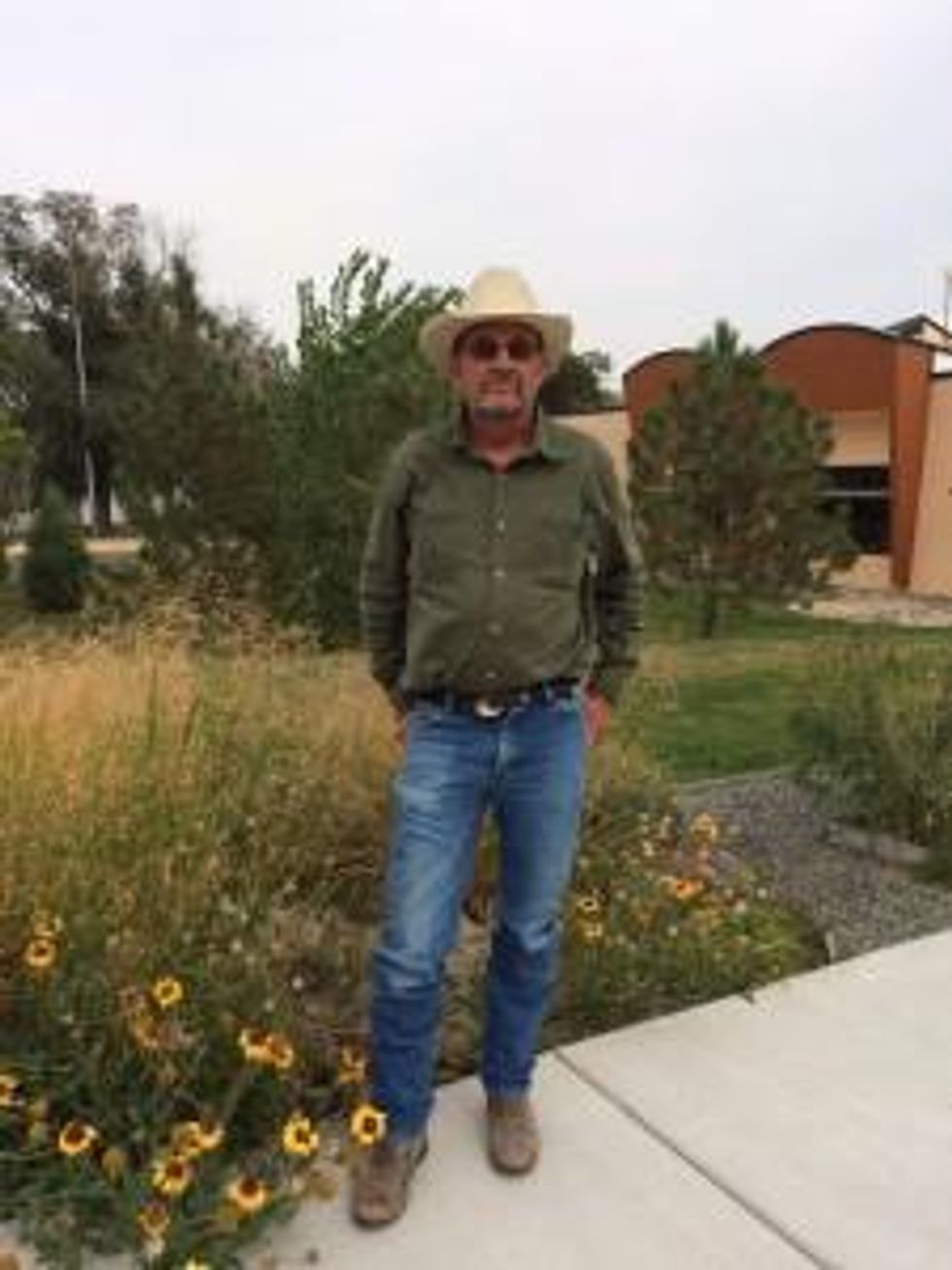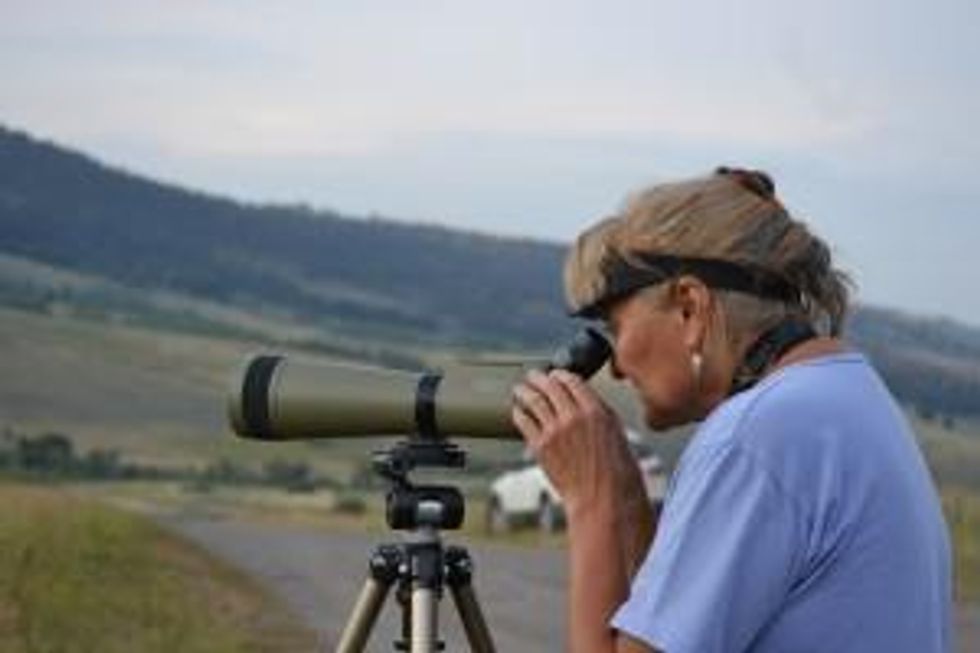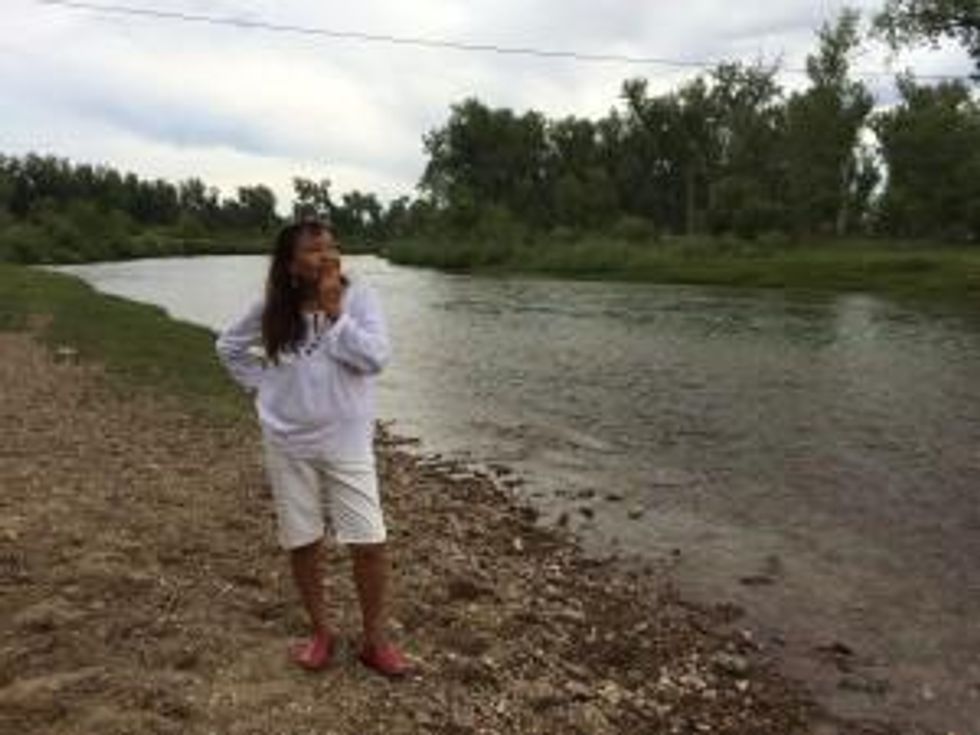

SUBSCRIBE TO OUR FREE NEWSLETTER
Daily news & progressive opinion—funded by the people, not the corporations—delivered straight to your inbox.
5
#000000
#FFFFFF
To donate by check, phone, or other method, see our More Ways to Give page.


Daily news & progressive opinion—funded by the people, not the corporations—delivered straight to your inbox.
I started on the Northwest part of this roadtrip to find the places where there is resistance to fossil fuel expansion, and I have found them. But I also found that many of the same people are not only rejecting a paradigm built on exploitation and domination, they are working to build a new post-industrial, post-oil way of life. This is not a left-right issue; it's happening in college towns, on ranches, Native reservations, and in small towns.
I've already reported on my conversation with George Price , a Native and African American professor at the University of Montana in Missouri, who cultivates a permaculture garden outside his home on the Flathead Reservation.
"We know the issues because we live them."Price was one of the main organizers of Missoula's protests of the megaloads. These huge truckloads of equipment are sent via highways to Alberta's tar sands where they are used to extract bitumen, a substance that can be refined into crude oil. On icy winter nights, protesters led by Native people waited by the highway for the loads to arrive. Then, in the middle of the street, they broke into round dances in and gave speeches to block the progress of these loads, even if only for a few moments.
I met two non-Native grandmothers, Carol Marsh and Claudia Brown, who were part of these protests and were arrested for sitting down in front of the megaloads.
One of the grandmothers told me: "We figured we had less to lose by being arrested at our age than a young Native guy would. To which one of the young native guys responded, 'Cool. When I get old, I want to go out and get arrested, too!'"
Marsh and Brown are involved in many other activities in Missoula, including a time bank and transition initiative.
In Billings, I visited the ranch of Steve Charter, chair of the Northern Plains Resource Council, a long-standing opponent of coal development founded by ranchers in the 1970s. He told me not only about opposition to new coal mining projects, but also about grazing practices that rebuild the ecological integrity of the soil, the productivity of range land, and the ability of the land to hold water and biodiversity. These practices can contribute to solving our climate crisis because the abundant microbial life absorbs and sequesters large quantities of carbon.

This new vision is about stewarding the land and animals rather than exploiting them, even if it takes more work. The good news is that this creates skilled jobs that could help bring young people back into ranching and farming, and could help bring about a resurgence in rural economies. Instead of emptying out, small rural towns based on the sustainable yields of healthy landscapes could become vibrant places for families.
So yes, I'm finding sources of hope, and not always where I expect.
I'm working now on a story about plans for the proposed Otter Creek coal mine in southeast Montana, and the ranchers, Native people, and environmentalists who are fighting it. The rural people I'm meeting are acting to protect their own valleys, rivers, and fisheries, but they are also acting for all of us -- no one is immune from the impacts of millions of tons of coal that will be burned if this mine and railroad spur go through.

The new vision is a rediscovery of what it means to be indigenous to a place. Indigenous is a quality of mind and a form of culture that does not belong to any one group. It grows out of a commitment to land, water, family, and community. Rediscovering this part of our heritage may be our best hope. It's a sense of sacred obligation that I heard over and over again from those working to stop the Otter Creek coal mine and block the related transportation corridors. And it turns out to be a powerful force.
"We know the issues because we live them," rancher Steve Charter told me. "That gives us credibility."
And it supplies motivation:

"People really care about this land and are willing to put up a fight," Brad Sauer, a rancher in the area of the proposed Otter Creek mine told me. "We'll stay up late at night to read documents and write letters. It all starts with a deep attachment to the land."
The emerging vision for Montana is growing out of a commitment people are making to their place. They are building ways of life that can sustain them, the land, water, and soil. Their approaches have huge implications for the climate crisis. And they're fighting for this, often against big corporations and government agencies captured by industry. Unlike the hit-and-run companies looking to exploit the land, these people can't just walk away when things get tough. They are taking responsibility and protecting what's sacred.
Follow the Edge of Change Road Trip here.
Dear Common Dreams reader, The U.S. is on a fast track to authoritarianism like nothing I've ever seen. Meanwhile, corporate news outlets are utterly capitulating to Trump, twisting their coverage to avoid drawing his ire while lining up to stuff cash in his pockets. That's why I believe that Common Dreams is doing the best and most consequential reporting that we've ever done. Our small but mighty team is a progressive reporting powerhouse, covering the news every day that the corporate media never will. Our mission has always been simple: To inform. To inspire. And to ignite change for the common good. Now here's the key piece that I want all our readers to understand: None of this would be possible without your financial support. That's not just some fundraising cliche. It's the absolute and literal truth. We don't accept corporate advertising and never will. We don't have a paywall because we don't think people should be blocked from critical news based on their ability to pay. Everything we do is funded by the donations of readers like you. Will you donate now to help power the nonprofit, independent reporting of Common Dreams? Thank you for being a vital member of our community. Together, we can keep independent journalism alive when it’s needed most. - Craig Brown, Co-founder |
I started on the Northwest part of this roadtrip to find the places where there is resistance to fossil fuel expansion, and I have found them. But I also found that many of the same people are not only rejecting a paradigm built on exploitation and domination, they are working to build a new post-industrial, post-oil way of life. This is not a left-right issue; it's happening in college towns, on ranches, Native reservations, and in small towns.
I've already reported on my conversation with George Price , a Native and African American professor at the University of Montana in Missouri, who cultivates a permaculture garden outside his home on the Flathead Reservation.
"We know the issues because we live them."Price was one of the main organizers of Missoula's protests of the megaloads. These huge truckloads of equipment are sent via highways to Alberta's tar sands where they are used to extract bitumen, a substance that can be refined into crude oil. On icy winter nights, protesters led by Native people waited by the highway for the loads to arrive. Then, in the middle of the street, they broke into round dances in and gave speeches to block the progress of these loads, even if only for a few moments.
I met two non-Native grandmothers, Carol Marsh and Claudia Brown, who were part of these protests and were arrested for sitting down in front of the megaloads.
One of the grandmothers told me: "We figured we had less to lose by being arrested at our age than a young Native guy would. To which one of the young native guys responded, 'Cool. When I get old, I want to go out and get arrested, too!'"
Marsh and Brown are involved in many other activities in Missoula, including a time bank and transition initiative.
In Billings, I visited the ranch of Steve Charter, chair of the Northern Plains Resource Council, a long-standing opponent of coal development founded by ranchers in the 1970s. He told me not only about opposition to new coal mining projects, but also about grazing practices that rebuild the ecological integrity of the soil, the productivity of range land, and the ability of the land to hold water and biodiversity. These practices can contribute to solving our climate crisis because the abundant microbial life absorbs and sequesters large quantities of carbon.

This new vision is about stewarding the land and animals rather than exploiting them, even if it takes more work. The good news is that this creates skilled jobs that could help bring young people back into ranching and farming, and could help bring about a resurgence in rural economies. Instead of emptying out, small rural towns based on the sustainable yields of healthy landscapes could become vibrant places for families.
So yes, I'm finding sources of hope, and not always where I expect.
I'm working now on a story about plans for the proposed Otter Creek coal mine in southeast Montana, and the ranchers, Native people, and environmentalists who are fighting it. The rural people I'm meeting are acting to protect their own valleys, rivers, and fisheries, but they are also acting for all of us -- no one is immune from the impacts of millions of tons of coal that will be burned if this mine and railroad spur go through.

The new vision is a rediscovery of what it means to be indigenous to a place. Indigenous is a quality of mind and a form of culture that does not belong to any one group. It grows out of a commitment to land, water, family, and community. Rediscovering this part of our heritage may be our best hope. It's a sense of sacred obligation that I heard over and over again from those working to stop the Otter Creek coal mine and block the related transportation corridors. And it turns out to be a powerful force.
"We know the issues because we live them," rancher Steve Charter told me. "That gives us credibility."
And it supplies motivation:

"People really care about this land and are willing to put up a fight," Brad Sauer, a rancher in the area of the proposed Otter Creek mine told me. "We'll stay up late at night to read documents and write letters. It all starts with a deep attachment to the land."
The emerging vision for Montana is growing out of a commitment people are making to their place. They are building ways of life that can sustain them, the land, water, and soil. Their approaches have huge implications for the climate crisis. And they're fighting for this, often against big corporations and government agencies captured by industry. Unlike the hit-and-run companies looking to exploit the land, these people can't just walk away when things get tough. They are taking responsibility and protecting what's sacred.
Follow the Edge of Change Road Trip here.
I started on the Northwest part of this roadtrip to find the places where there is resistance to fossil fuel expansion, and I have found them. But I also found that many of the same people are not only rejecting a paradigm built on exploitation and domination, they are working to build a new post-industrial, post-oil way of life. This is not a left-right issue; it's happening in college towns, on ranches, Native reservations, and in small towns.
I've already reported on my conversation with George Price , a Native and African American professor at the University of Montana in Missouri, who cultivates a permaculture garden outside his home on the Flathead Reservation.
"We know the issues because we live them."Price was one of the main organizers of Missoula's protests of the megaloads. These huge truckloads of equipment are sent via highways to Alberta's tar sands where they are used to extract bitumen, a substance that can be refined into crude oil. On icy winter nights, protesters led by Native people waited by the highway for the loads to arrive. Then, in the middle of the street, they broke into round dances in and gave speeches to block the progress of these loads, even if only for a few moments.
I met two non-Native grandmothers, Carol Marsh and Claudia Brown, who were part of these protests and were arrested for sitting down in front of the megaloads.
One of the grandmothers told me: "We figured we had less to lose by being arrested at our age than a young Native guy would. To which one of the young native guys responded, 'Cool. When I get old, I want to go out and get arrested, too!'"
Marsh and Brown are involved in many other activities in Missoula, including a time bank and transition initiative.
In Billings, I visited the ranch of Steve Charter, chair of the Northern Plains Resource Council, a long-standing opponent of coal development founded by ranchers in the 1970s. He told me not only about opposition to new coal mining projects, but also about grazing practices that rebuild the ecological integrity of the soil, the productivity of range land, and the ability of the land to hold water and biodiversity. These practices can contribute to solving our climate crisis because the abundant microbial life absorbs and sequesters large quantities of carbon.

This new vision is about stewarding the land and animals rather than exploiting them, even if it takes more work. The good news is that this creates skilled jobs that could help bring young people back into ranching and farming, and could help bring about a resurgence in rural economies. Instead of emptying out, small rural towns based on the sustainable yields of healthy landscapes could become vibrant places for families.
So yes, I'm finding sources of hope, and not always where I expect.
I'm working now on a story about plans for the proposed Otter Creek coal mine in southeast Montana, and the ranchers, Native people, and environmentalists who are fighting it. The rural people I'm meeting are acting to protect their own valleys, rivers, and fisheries, but they are also acting for all of us -- no one is immune from the impacts of millions of tons of coal that will be burned if this mine and railroad spur go through.

The new vision is a rediscovery of what it means to be indigenous to a place. Indigenous is a quality of mind and a form of culture that does not belong to any one group. It grows out of a commitment to land, water, family, and community. Rediscovering this part of our heritage may be our best hope. It's a sense of sacred obligation that I heard over and over again from those working to stop the Otter Creek coal mine and block the related transportation corridors. And it turns out to be a powerful force.
"We know the issues because we live them," rancher Steve Charter told me. "That gives us credibility."
And it supplies motivation:

"People really care about this land and are willing to put up a fight," Brad Sauer, a rancher in the area of the proposed Otter Creek mine told me. "We'll stay up late at night to read documents and write letters. It all starts with a deep attachment to the land."
The emerging vision for Montana is growing out of a commitment people are making to their place. They are building ways of life that can sustain them, the land, water, and soil. Their approaches have huge implications for the climate crisis. And they're fighting for this, often against big corporations and government agencies captured by industry. Unlike the hit-and-run companies looking to exploit the land, these people can't just walk away when things get tough. They are taking responsibility and protecting what's sacred.
Follow the Edge of Change Road Trip here.